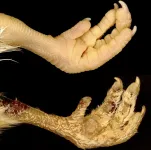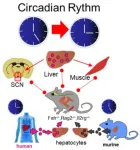(Press-News.org) Many owners of electric vehicles worry about how effective their battery will be in very cold weather. Now a new battery chemistry may have solved that problem.
In current lithium-ion batteries, the main problem lies in the liquid electrolyte. This key battery component transfers charge-carrying particles called ions between the battery’s two electrodes, causing the battery to charge and discharge. But the liquid begins to freeze at sub-zero temperatures. This condition severely limits the effectiveness of charging electric vehicles in cold regions and seasons.
To address that problem, a team of scientists from the U.S. Department of Energy’s (DOE) Argonne and Lawrence Berkeley national laboratories developed a fluorine-containing electrolyte that performs well even in sub-zero temperatures.
“Our research thus demonstrated how to tailor the atomic structure of electrolyte solvents to design new electrolytes for sub-zero temperatures.” — John Zhang, Argonne group leader
“Our team not only found an antifreeze electrolyte whose charging performance does not decline at minus 4 degrees Fahrenheit, but we also discovered, at the atomic level, what makes it so effective,” said Zhengcheng “John” Zhang, a senior chemist and group leader in Argonne’s Chemical Sciences and Engineering division.
This low-temperature electrolyte shows promise of working for batteries in electric vehicles, as well as in energy storage for electric grids and consumer electronics like computers and phones.
In today’s lithium-ion batteries, the electrolyte is a mixture of a widely available salt (lithium hexafluorophosphate) and carbonate solvents such as ethylene carbonate. The solvents dissolve the salt to form a liquid.
When a battery is charged, the liquid electrolyte shuttles lithium ions from the cathode (a lithium-containing oxide) to the anode (graphite). These ions migrate out of the cathode, then pass through the electrolyte on the way into the anode. While being transported through the electrolyte, they sit at the center of clusters of four or five solvent molecules.
During the initial few charges, these clusters strike the anode surface and form a protective layer called the solid-electrolyte interphase. Once formed, this layer acts like a filter. It allows only the lithium ions to pass through the layer while blocking the solvent molecules. In this way, the anode is able to store lithium atoms in the structure of the graphite on charge. Upon discharge, electrochemical reactions release electrons from the lithium that generate electricity that can power vehicles.
The problem is that in cold temperatures, the electrolyte with carbonate solvents begins to freeze. As a result, it loses the ability to transport lithium ions into the anode on charge. This is because the lithium ions are so tightly bound within the solvent clusters. Hence, these ions require much higher energy to evacuate their clusters and penetrate the interface layer than at room temperature. For that reason, scientists have been searching for a better solvent.
The team investigated several fluorine-containing solvents. They were able to identify the composition that had the lowest energy barrier for releasing lithium ions from the clusters at sub-zero temperature. They also determined at the atomic scale why that particular composition worked so well. It depended on the position of the fluorine atoms within each solvent molecule and their number.
In testing with laboratory cells, the team’s fluorinated electrolyte retained stable energy storage capacity for 400 charge-discharge cycles at minus 4 F. Even at that sub-zero temperature, the capacity was equivalent to that of a cell with a conventional carbonate-based electrolyte at room temperature.
“Our research thus demonstrated how to tailor the atomic structure of electrolyte solvents to design new electrolytes for sub-zero temperatures,” Zhang said.
The antifreeze electrolyte has a bonus property. It is much safer than the carbonate-based electrolytes that are currently used, since it will not catch fire.
“We are patenting our low-temperature and safer electrolyte and are now searching for an industrial partner to adapt it to one of their designs for lithium-ion batteries,” Zhang said.
This research appears in Advanced Energy Materials. In addition to John Zhang, Argonne authors are Dong-Joo Yoo, Qian Liu and Minkyu Kim. Berkeley Lab authors are Orion Cohen and Kristin Persson.
This work was funded by the DOE Office of Energy Efficiency and Renewable Energy, Vehicle Technologies Office.
Argonne National Laboratory seeks solutions to pressing national problems in science and technology. The nation’s first national laboratory, Argonne conducts leading-edge basic and applied scientific research in virtually every scientific discipline. Argonne researchers work closely with researchers from hundreds of companies, universities, and federal, state and municipal agencies to help them solve their specific problems, advance America’s scientific leadership and prepare the nation for a better future. With employees from more than 60 nations, Argonne is managed by UChicago Argonne, LLC for the U.S. Department of Energy’s Office of Science.
The U.S. Department of Energy’s Office of Science is the single largest supporter of basic research in the physical sciences in the United States and is working to address some of the most pressing challenges of our time. For more information, visit https://energy.gov/science.
END
An electric vehicle battery for all seasons
New electrolyte for lithium-ion batteries performs well in frigid regions and seasons
2023-05-17
ELSE PRESS RELEASES FROM THIS DATE:
One step closer to developing a potentially ultraprotective sunscreen from our own melanin
2023-05-17
A new discovery about the structure of melanin has brought scientists one step closer to developing a new, potentially ultra-protective sunscreen derived from a biological substance found in nearly all organisms. Researchers from McGill’s Department of Chemistry, in collaboration with The Ohio State University and the University of Girona, have announced a major advance in understanding the fundamental structure of melanin and one of its components that turns light into heat, protecting the body from sun damage.
Melanin, the pigment that gives humans their skin, eye, and hair colour, is the body’s first and best natural defense against the sun’s ...
Siblings can "pave the way" when they have a similar "Big Five" personality - with introverted siblings being more likely to leave home once their similarly introverted brother or sister has done so
2023-05-17
Siblings can "pave the way" when they have a similar "Big Five" personality - with introverted siblings being more likely to leave home once their similarly introverted brother or sister has done so
###
Article URL: https://journals.plos.org/plosone/article?id=10.1371/journal.pone.0284808
Article Title: Do birds of a feather leave the nest together? The role of sibling personality similarity in the transition to adulthood
Author Countries: Belgium.
Funding: This research has been made possible through the grant Nr. G017519N ...
Households whose "heads" score highly for openness and conscientiousness are more likely to make higher charitable donations, according to Chinese study incorporating "Big Five" personality traits
2023-05-17
Households whose "heads" score highly for openness and conscientiousness are more likely to make higher charitable donations, according to Chinese study incorporating "Big Five" personality traits
###
Article URL: https://journals.plos.org/plosone/article?id=10.1371/journal.pone.0284798
Article Title: A study on the influence of personality characteristics on household charitable donation behavior in China
Author Countries: China
Funding: Funding was provided by Shenzhen Key Research ...
Sustainable agriculture is building peace in Colombia
2023-05-17
In areas of Colombia once controlled by guerillas, conflicts over land continue and deforestation has risen considerably. But it’s in these same areas that researchers have found that farmers implementing sustainable land use systems, like agroforestry driven by cocoa (one of the key ingredients of chocolate), has contributed to reducing conflicts.
Deforestation and Conflict
In 2016, the government of Colombia signed a peace treaty with the guerilla group Revolutionary Armed Forces of Colombia (FARC, for its initials in Spanish) and in the following years, forested areas formerly controlled by the FARC saw an influx of other illegal actors, contributing ...
Australian nanomedicine research a ‘milestone’ in the treatment of childhood cancer
2023-05-17
Australian nanomedicine researchers have come up with a new approach to solving a decades-old clinical problem: getting treatment drugs to act selectively on cancer cells in the body. Published this week in the high-impact journal Science Translational Medicine, the research paves the way to safer and more effective treatment options for children with aggressive blood cancers, and potentially other types of cancer as well.
Chemotherapy is the mainstay of treatment for leukaemia, the most common blood cancer in children. However, while chemotherapy can be very effective for certain types of leukaemia, ...
Scales or feathers? It all comes down to a few genes
2023-05-17
Scales, spines, feathers and hair are examples of vertebrate skin appendages, which constitute a remarkably diverse group of micro-organs. Despite their natural multitude of forms, these appendages share early developmental processes at the embryonic stage. Two researchers from the University of Geneva (UNIGE) have discovered how to permanently transform the scales that normally cover the feet of chickens into feathers, by specificially modifying the expression of certain genes. These results, published in the journal Science Advances, open new perspectives for studying mechanisms that have enabled radical evolutionary ...
New study explains how a common virus can cause multiple sclerosis
2023-05-17
Researchers at Karolinska Institutet in Sweden have found further evidence for how the Epstein-Barr virus can trigger multiple sclerosis or drive disease progression. A study published in Science Advances shows that some individuals have antibodies against the virus that mistakenly attack a protein in the brain and spinal cord.
The Epstein-Barr virus (EBV) infects most people early in life and then remains in the body, usually without causing symptoms. The link between EBV and the neurological disease multiple sclerosis (MS) was discovered many years ago and has puzzled ...
Liver cells control our biological clock
2023-05-17
Organisms rely on a biological clock known as the ‘circadian’ clock to regulate their activity according to the time of day. A central clock, constituted by a group of brain cells — the suprachiasmatic nuclei, or SCN — synchronises the circadian clocks present in all body’s organs, called ‘peripheral’ clocks. Until now, synchronisation of the circadian cycle in mammals was thought to be a one-way mechanism in which the suprachiasmatic nuclei alone synchronized the peripheral ...
Adult friendships can triumph over childhood trauma, even in baboons
2023-05-17
DURHAM, N.C. -- Decades of research show that experiencing traumatic things as a child -- such as having an alcoholic parent or growing up in a tumultuous home -- puts you at risk for poorer health and survival later in life.
But mounting evidence suggests that forging strong social relationships can help mitigate these effects. And not just for people, but for our primate cousins, too.
Drawing on 36 years of data, a new study of nearly 200 baboons in southern Kenya finds that adversity early in life can take years off their lifespan, but strong social bonds with other baboons in adulthood can help ...
Using COVID-19 positive donor hearts may impact post-transplant survival
2023-05-17
Heart transplant recipients receiving organs from active COVID-19 positive donors may have an increased risk of death at six months and one year when compared to those receiving organs from recently recovered COVID-19 patients and COVID-19 negative patients, according to a study published today in the Journal of the American College of Cardiology.
“These early trends should be concerning enough such that heart transplantation centers need to thoroughly evaluate and continue to weigh the risks/benefits of using hearts from active COVID-19 donors,” said Shivank Madan, MD, MHA, lead author of the study and a cardiologist ...
LAST 30 PRESS RELEASES:
Sleeping in on weekends may help boost teens’ mental health
Study: Teens use cellphones for an hour a day at school
After more than two years of war, Palestinian children are hungry, denied education and “like the living dead”
The untold story of life with Prader-Willi syndrome - according to the siblings who live it
How the parasite that ‘gave up sex’ found more hosts – and why its victory won’t last
When is it time to jump? The boiling frog problem of AI use in physics education
Twitter data reveals partisan divide in understanding why pollen season's getting worse
AI is quick but risky for updating old software
Revolutionizing biosecurity: new multi-omics framework to transform invasive species management
From ancient herb to modern medicine: new review unveils the multi-targeted healing potential of Borago officinalis
Building a global scientific community: Biological Diversity Journal announces dual recruitment of Editorial Board and Youth Editorial Board members
Microbes that break down antibiotics help protect ecosystems under drug pollution
Smart biochar that remembers pollutants offers a new way to clean water and recycle biomass
Rice genes matter more than domestication in shaping plant microbiomes
Ticking time bomb: Some farmers report as many as 70 tick encounters over a 6-month period
Turning garden and crop waste into plastics
Scientists discover ‘platypus galaxies’ in the early universe
Seeing thyroid cancer in a new light: when AI meets label-free imaging in the operating room
Neutrophil-to-lymphocyte ratio may aid risk stratification in depressive disorder
2026 Seismological Society of America Annual Meeting
AI-powered ECG analysis offers promising path for early detection of chronic obstructive pulmonary disease, says Mount Sinai researchers
GIMM uncovers flaws in lab-grown heart cells and paves the way for improved treatments
Cracking the evolutionary code of sleep
Medications could help the aging brain cope with surgery, memory impairment
Back pain linked to worse sleep years later in men over 65, according to study
CDC urges ‘shared decision-making’ on some childhood vaccines; many unclear about what that means
New research finds that an ‘equal treatment’ approach to economic opportunity advertising can backfire
Researchers create shape-shifting, self-navigating microparticles
Science army mobilizes to map US soil microbiome
Researchers develop new tools to turn grain crops into biosensors
[Press-News.org] An electric vehicle battery for all seasonsNew electrolyte for lithium-ion batteries performs well in frigid regions and seasons




